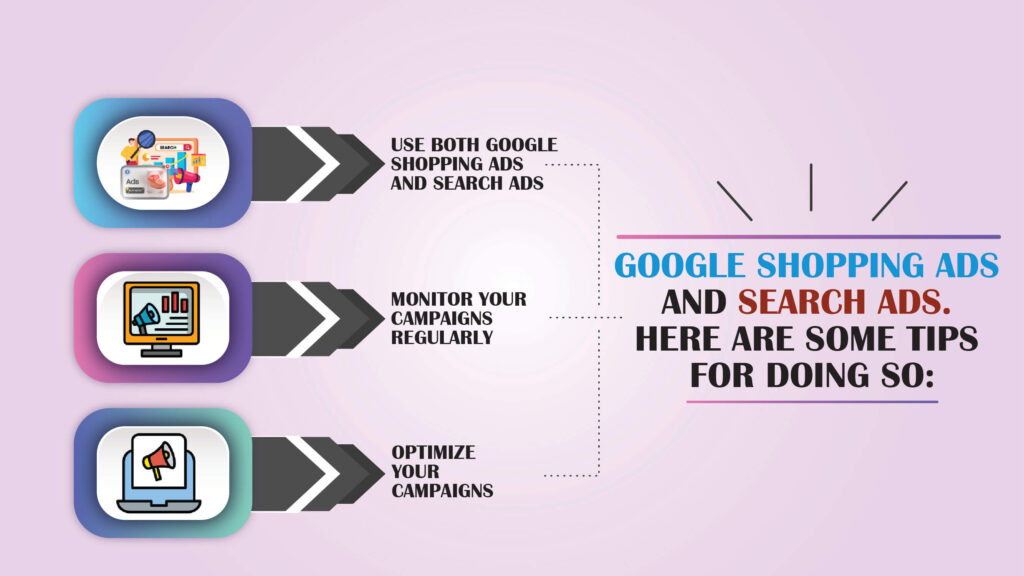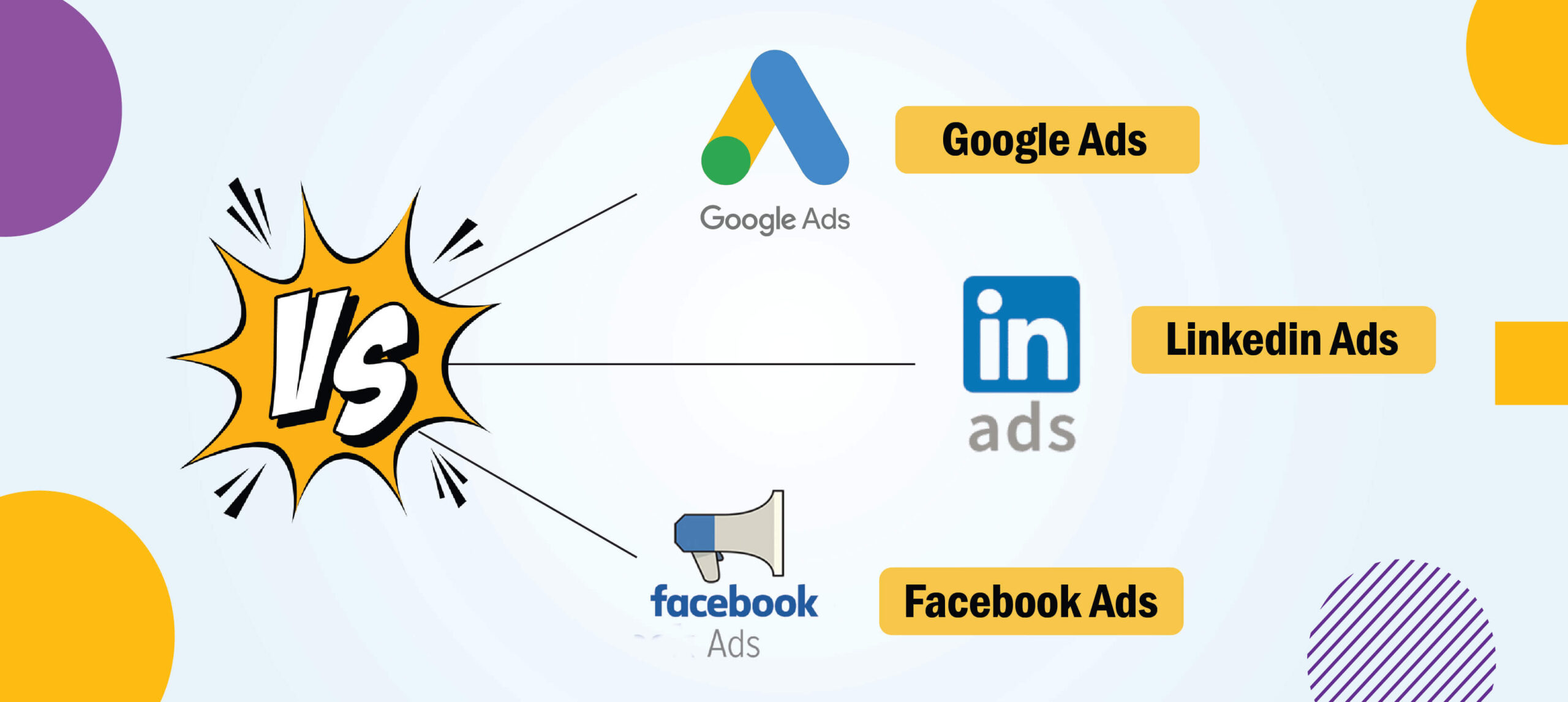Introduction
Online advertising is one of most effective strategies for businesses looking to promote their product and services. And Google ads is the ultimate source of that effective online advertising, offering various advertising ways that suits and benefits your business.
Two of the most common Google Ads formats are Google Shopping Ads and Search Ads. In this article, we’ll compare these effective formats and see how it benefits the other businesses.
Also Read: Pinterest Ads Vs Facebook Ads
Google Search Ads:
Google Search Ads are basically known as text-based ads that appear at the top and bottom of Google’s search engine results pages (SERPs) when users search for specific related keywords.
These ads target based on the users search query, and also businesses would have to only pay when someone clicks on that ads.
Advantages of Google Search Ads include:
- High visibility: Google Search Ads appear on the top of the Google search results, making them highly visible to users.
- Targeted advertising: Search Ads also allows businesses to target users based on the specific keyword searches related to their products or services, which increases the chances of getting a lead or conversion.
- Measurable results: Google Ads provides detailed performance analysis for each ad, effectively allowing businesses to track their return on investment (ROI) and make data-driven decisions.
Disadvantages of Google Search Ads include:
- High competition: Popular keywords can be highly competitive, making it difficult for smaller businesses to compete.
- Limited ad space: As you know there is limited Ads space on Google’s SERPs, making it highly competitive.
- Ad fatigue: Users may sometimes get frustrated by seeing the same ads repeatedly, leading to ad fatigue and a decrease in performance over time.
Overall, Google Search can be a game changing factor for businesses who are looking to increase their online visibility and drive conversions. However, it’s also important to know the advantages and disadvantages to determine if this approach is right for your business’s needs.
Also Read: Tik Tok Ads Vs Facebook Ads
Google Shopping Ads:
Google Shopping Ads are basically a type of online advertising format that allows businesses to showcase their products on Google’s search results page and Google Shopping tab.
Google Shopping Ads is a visual way of showing product images, prices, and store information to potential customers.
Here’s how Google Shopping Ads work:
- First of all a business creates a Google Merchant Center account and uploads their product feed.
- Then next it creates a Google Ads account and links it to their Merchant Center account.
- And then the business creates a Shopping campaign and sets bids for their products.
- Now Google’s algorithm decides when to show the Shopping Ads based on a user search query and bid.
Advantages of Google Shopping Ads include:
- It helps to increase the visibility for products on Google search results.
- Google ads help to showcase product images and prices, which can attract clicks from the interested consumers.
- Automatic product data updates from the Merchant Center feed, which saves time and ensures accuracy.
Disadvantages of Google Shopping Ads include:
- Google shopping ads are higher in terms of cost per click when compared to Search Ads.
- Google shopping ads have less control over keyword targeting compared to Search Ads.
- Google shopping ads can be a highly competitive landscape for certain products.
Overall, Google Shopping Ads can be an effective way for businesses to promote their products online and drive sales.
Google Shopping Ads vs Search Ads: Comparison
Although both Google Shopping Ads and Search Ads are types of online advertising on Google but they do differ in their format, targeting, and strategy.
Differences between Google Shopping Ads and Search Ads:
- Format: Google Shopping Ads mainly shows product images, prices, and store information, while on the other hand Search Ads shows text-based ads with headlines, descriptions, and URLs.
- Targeting: Google Shopping Ads mainly focuses on products and shows ads to users who are actively searching for that specific product online. Search Ads mainly focuses on keywords and shows to users who are searching for certain terms.
- Strategy: Google Shopping Ads require a product feed and optimization of product data, while Search Ads require keyword search and ad copywriting.
Pros and cons of each approach:
Google Shopping Ads:
- Pros: Visual format can attract more clicks more relevant to product searches, automatic product data updates.
- Cons: In Google ads you have to pay Higher cost per click, and also you will have less control over keyword targeting.
Search Ads:
- Pros: Google search ads has more control over keyword targeting and can also be less expensive as compared to Shopping Ads.
- Cons: The main disadvantages is it have Limited ad space which makes it less visually appealing than Google Shopping Ads.
When to use Google Shopping Ads vs Search Ads:
Google Shopping Ads:
- Prioritize Google Shopping Ads for businesses with physical products to sell.
- Prioritize Google Shopping Ads for businesses with a large inventory of products.
Search Ads:
- Prioritize Search Ads for businesses with a service-based offering.
- Prioritize Search Ads for businesses with a smaller inventory of products.
Examples of businesses that prioritize Google Shopping Ads vs Search Ads:
- An e-commerce retailer selling a variety of products may give more preference to Google Shopping Ads to showcase their inventory and drive sales.
- According to the research conducted by Sujit Shukla, A local service-based business, such as a plumber or lawyer, may give higher preference to Search Ads to attract potential customers in their area.
Ultimately, the decision to use Google Shopping Ads vs Search Ads depends on a business’s goals, target audience, and budget. It may be very much effective to test both approaches and adjust the strategy accordingly.
Choosing the Right Advertising Strategy:

Choosing the right advertising strategy is very important for the success of your business. When deciding between Google Shopping Ads and Search Ads, there are several other factors to consider.
- Business Goals: The first thing you have to keep in mind is your business goal. Is your goal to increase brand awareness, drive traffic to your website, or generate sales? Google Shopping Ads are great for businesses that sell physical products and want to increase sales. On the other hand, Search Ads are those who want to drive more traffic on their website and create brand awareness.
- Budget: Budget is another important factor to consider when choosing between Google Shopping Ads and Search Ads. Google Shopping Ads is comparatively more expensive than Search Ads because they require more upfront investment. However,they also give better results as compared to search ads by generating more sales, making them a better option for businesses with a larger budget.
- Product Catalog: If you have a large product catalog, Google Shopping Ads may be the better option for you. They allow you to showcase your products to a wider audience, increasing your chances of generating sales. Search Ads, on the other hand, are better for businesses with limited product catalog.
- Target Audience: it’s important to consider your target audience. Google Shopping Ads are great for businesses targeting who are looking to buy the product. Search Ads are better for businesses targeting consumers who are still in the research phase and may not be ready to make a purchase yet.
To maximize the impact of your online advertising, it’s important to balance google shopping ads and search ads for maximum impact.
Google Shopping Ads and Search Ads. Here are some tips for doing so:

- Use both Google Shopping Ads and Search Ads: By using both Google Shopping Ads and Search Ads, you can reach more and more audience and will also have the chance to generate more sales.
- Monitor your campaigns regularly: It is very important to monitor your campaigns on a regular basis to ensure that you’re getting the best return on your investment. This will allow you to make any necessary adjustments to your campaigns to ensure that they’re performing and will also help you to make an informed decision.
- Optimize your campaigns: Finally, it’s important to optimize your campaigns for maximum impact. This includes using the right keywords, targeting the right audience, and creating compelling ad copy.
Many businesses have successfully used both Google Shopping Ads and Search Ads to increase sales and drive traffic to their website. One the popular example is Amazon.
Amazon uses Google Shopping Ads to promote their products and Search Ads to drive traffic to their website.
Another big example is clothing retailer Nordstrom.They use Google Shopping Ads to promote their clothing ads on the Search Ads to drive traffic to their website and increase brand awareness.
Conclusion
Well in conclusion we just want to say one thing that both Google Shopping Ads and Search Ads are two of the most effective online strategies that can help businesses reach their target audience and drive conversions.
While Google Shopping Ads are best suited for businesses with a physical product to sell, On the other hand Search Ads are ideal for businesses offering a service or solution to a problem.
When choosing between the two strategies, businesses should consider several factors such as budget, target audience, and marketing goals. It’s also important to regularly monitor the ad campaigns.
For businesses looking to improve their online advertising performance, we recommend testing both Google Shopping Ads and Search Ads to determine which ads align best with their business needs. With the right approach and ongoing optimization, businesses can effectively use these advertising strategies to drive traffic, sales, and growth.






